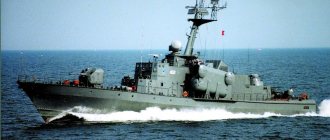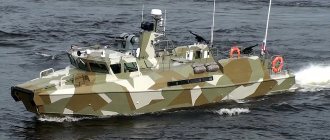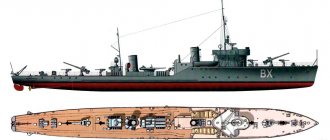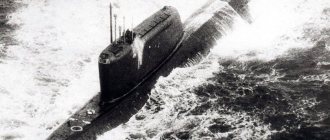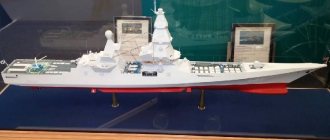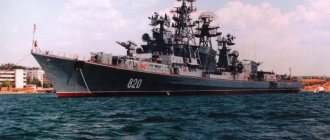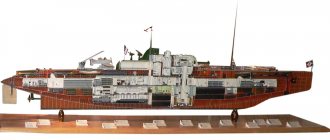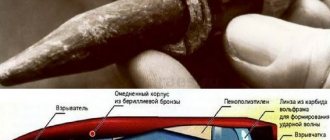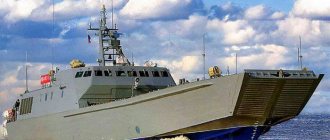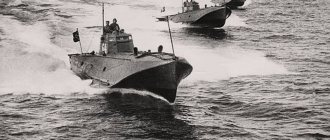The priorities of the Russian shipbuilding program raise questions
Artillery boats (AKA) of the Caspian flotilla AK-201, AK-209 and AK-248 of project 1204 “Bumblebee” arrived in St. Petersburg, where they are participating in rehearsals for the main naval parade on the occasion of Navy Day, which will be celebrated July 29. According to Russian Defense Minister Sergei Shoigu, these boats will open the historical part of the parade. They will carry over the Neva the battle flags of the famous Marine Corps formations that heroically defended and liberated Leningrad, Sevastopol and Novorossiysk during the Great Patriotic War.
AKA Project 1204 “Bumblebee” really has a rich history, although it has nothing to do with the Great Patriotic War. The boats appeared more than two decades after its completion. But the reason for their creation is instructive.
"RIVER TANKS"
During the Great Patriotic War, armored boats (BKA) of projects 1124 and 1125, created under the leadership of Julius Yulievich Benois (1908-1966), a representative of the famous dynasty of domestic architects and artists, became deservedly famous. “River tanks”, equipped with artillery tank turrets, became famous in the battles on Pripyat and the Dnieper, they took part in the Battle of Stalingrad and the defense of the Road of Life on Ladoga, and they were used by marine landing forces in the Baltic and the Black Sea. Armored boats also played a significant role in the liberation of Europe from the fascist yoke. If the armored boats of the Danube Flotilla had not taken control of the Vienna bridges in a timely manner, it is still unknown what the fate of the Austrian capital would have been. The BKA completed its combat journey on the Sungari and Ussuri rivers, where they participated in the capture of a number of Manchurian cities captured by the Japanese. It is worth noting that the boats of projects 1124 and 1125 were one of the first missile ships of our fleet, since some of them were equipped with Katyusha MLRS launchers.
After the war, the team led by Julius Benoit continued to work on “river tanks”. The project of the small armored boat 191M turned out to be the most successful. It almost fully met the requirements for ships of this class. In the central part of the boat there was an armored citadel that protected the crew, power plant and weapons, and the thickness of the upper armored deck was increased to 10 mm. It withstood hits not only from bullets, but also from small-caliber shells. To improve seaworthiness, the camber of the sides was increased. The power of artillery weapons has increased significantly. The ship's universal 85-mm artillery mount MK-85, located in an armored turret, although it resembled a tank gun, was specially designed for the BKA. Its elevation angle was 77 degrees, which made it possible to shoot at air targets, as well as fire “mortar style”, covering objects located on a high bank with fire. Two armored turrets contained twin 14.5 mm 2M-6 machine guns, plus they could take up to 8 minutes. The boats reached a speed of 24 knots, and their cruising range with a crew of 15 people exceeded 500 miles.
118 Project 191M boats were built for the USSR Navy. Project 192 BKA should have become even more advanced. They had an improved reservation system. But the fleet received only two such UAVs, since the military-political leadership of the country decided to abandon the construction of ships that did not meet the “requirements of the time.” And in 1958, all river flotillas were disbanded, since “the Soviet Union was now surrounded by fraternal and friendly countries.” The combat units that made them up were “put on pins and needles.”
Crossing Breachers
The outbreak of the Great Patriotic War, especially the experience of using the Pinsk flotilla, pushed the Navy command to the idea of creating a combat boat designed to destroy river crossings, or, as it was then called, a “crossing breaker.” The first preliminary design of such a boat, No. 170, appeared in December 1941. Although it had a 76-mm tank gun, it was still primarily a mortar ship. Two T-17 tank engines were planned as the main power plant. This project participated in the competition along with the KVV boats, but it was rejected in favor of the KVV-2. However, the idea of a crossing breaker boat was considered relevant, and in February 1942 a second version of Project 170 appeared. With a displacement of 74.5 tons, a length of 26.6 m, a width of 4.2 m, a draft of 1.07 m and a boat height of 1.57 m, they wanted to equip the boat with one T-34 turret with 80 rounds of ammunition and an M-13 installation -M with 32 NURS ammunition, as well as two DShMM-2B turrets. The engines were replaced with two GAM-34-BS, which, with a fuel supply of 2.8 tons, provided a maximum speed of 17 knots and a cruising range of 7 knots - 300 miles. The boat's hull was original: the bow and stern ends were made of steel, and the citadel (17-42 ships) was made of reinforced concrete. At the same time, the thickness of the side reached 200 mm, the deck - 70 mm and the traverse - 100 mm. Crew 14 people. The project was not implemented. Partly due to the lack of factory capacity, but more due to the fact that by the spring of 1942, the fight against enemy river crossings was not a priority task of the Soviet Navy. They remembered it only once more in June 1944. Then five armored boats of the Dnieper flotilla suddenly attacked a crossing on the Berezina River near the village of Parichi. All they were able to achieve at the cost of severe damage to all five units was to briefly introduce an element of panic into the crossing troops; they were saved by the fact that they attacked upstream, and therefore the half-destroyed armored boats that had lost their speed were carried out of the enemy’s fire zone by the current. But the spoon is good for lunch and, having complained about the lack of specialized boats for breaking through crossings, they were no longer remembered.
SPIRAL OF HISTORY
A decade and a half later, this decision, as they say, backfired. When Soviet-Chinese relations began to rapidly deteriorate in the mid-1960s, they remembered the armored boats on the Amur, which had long since been scrapped. The creator of “river tanks”, Julius Benois, was called upon again. By that time, he was working on a completely different topic - hovercraft. I had to remember the old things. The order for the creation of a small artillery boat (AKA) had to be implemented with a deadline of “yesterday”.
It must be said frankly that the Project 1204 Shmel AKA was inferior to the Project 191M BKA. But it still turned out to be a very good and fairly well-armed armored river boat. With a total displacement of more than 77 tons and a 24-knot speed, it carried a 76 mm cannon in the turret of a PT-76 tank, coaxial with a 7.62 mm machine gun, as well as a coaxial 14.5 mm machine gun (later replaced by a coaxial 25 -mm automatic 2M-3M) and a 17-barreled 140-mm MLRS BM-14-17 with a range of destruction of coastal targets of 9–10 km. “Bumblebees” were intended for patrol service on rivers and lakes, destroying enemy river vessels and combat boats, assisting ground forces with artillery and machine-gun fire, transferring airborne assault groups to the landing site, as well as for operations in shallow coastal areas of the seas.
Julius Benoit himself did not see his “Bumblebee”, as well as the amphibious landing craft “Jeyran” of Project 1232, on the water. The designer died in 1966. His projects were completed by his companions. In 1967–1972, 118 AKA Project 1204 were built at four factories: 56 boats were received by the USSR Navy, and 62 by naval units of the KGB Border Troops. To date, only four “bumblebees” remain in the Caspian Sea in the Russian Navy.
It is worth paying attention to the fact that the demand for them, especially this year, has increased. The AKA-248 of Project 1204 was involved in the parade on the occasion of the 100th anniversary of the Southern Military District on May 5 this year in Rostov-on-Don. As we know, the main naval parade in St. Petersburg will be opened by three “bumblebees”.
However, these artillery boats serve not only as parade guards. After the aggravation of the situation in the Sea of Azov due to the pirate seizure by the patrol boat “Oniks” of the Sea Guard, that is, the Coast Guard of Ukraine, the Russian trawler “Nord” was transferred to Kerch from the Caspian Sea AKA-201 and AKA-248. So what to do? After all, rumors began to circulate that the Project 205P Tarantul border patrol ship “Donbass” was being urgently repaired in Mariupol. It is equipped with two twin 30 mm AK-230 automatic cannons. That is, the Russian border boats armed with machine guns deployed in the Sea of Azov have nothing to oppose him. Here we remembered the Caspian “bumblebees”.
Description of the design of the artillery boat
The durable hull of the Project 1204 AKA is made of smooth-deck steel; in the engine area, in the underwater part, a tunnel is formed. The artillery boat is divided into the following sections:
- The main hull compartment of the vessel is the forepeak;
- Living quarters for the ship's crew - cockpit;
- The space in the hull, limited in length by transverse bulkheads and in width by sides, is the bow artillery compartment;
- Two rooms for the team to spend time - the crew quarters;
- Commander's radio room
- Engine control compartment;
- Generator and engine compartment;
- Aft compartment;
- A room specially equipped for cooking - a galley;
- The outermost aft compartment on the ship is the afterpeak.
Vietnamese artillery ship
The artillery boat had a reserved wheelhouse, deck in the area of the engine room and control station, sides and barbette of the turret, where ammunition was located. The energy design had an installation of two engines with a power of 1200 horsepower. The electrical system consisted of two automated generators with a power of 25 kW and a current voltage of 380 watts. The autonomous engine cooling system was carried out using seawater. The boat was equipped with lighting in the form of a spotlight of the K-35-3TM series. The gyromagnetic compass served as a navigational weapon. There are two types of radio communications on board the ship:
- VHF radio station R-619-1 Graphite;
- HF radio station R-617 Argon-Fluorine-K.
The boat could stay on the water for up to 7 days and had a fuel reserve of up to 5 tons. The artillery boat could sail 320 miles at a speed of 10 knots. The rooms in which the crew were located were isolated from the engine compartment and were located in the bow of the hull. Artificial ventilation was installed in them.
AKA project 1204
Armed
Rails were designed at the stern of the vessel, where 14 marine galvanic shock and bottom mines were placed. When planning missile weapons, they decided to install a launcher with 17 guides arranged in two rows. There were 8 guides in the first row, and one more in the top row. The lifting mechanism carried out loading and targeting, but a huge disadvantage of this installation was that firing at specified targets could only take place from a stationary boat. The missile weapons were controlled manually. A machine gun with a wide elevation angle and all-round firing served as an anti-aircraft weapon; subsequently it was decided to replace it with a 25 mm double-barreled artillery mount. In the shape of a truncated cone, the boat had a PT-76B tank turret, which was constructed of sheet armor and was intended for firing at enemy surface targets. The artillery boat is also equipped with a 76-mm D-56TS cannon with a muzzle brake, the rate of fire of which is 7 rounds per minute. The boat has the following armor sections:
- Armor belt;
- Chopping;
- Engine room on deck;
- Engine control station;
- Barbet turrets and ZPU.
Project 12300 missile and artillery boat "Scorpion"
A total of 118 artillery boats were produced, of which 62 boats were used by the border troops of the KGB of the USSR and 56 by the Navy of the USSR. During operation, minor changes were made to the vessel's armor, and two ammunition loads of Strela-2M MANPADS missiles were added. Today, only 16 boats of this type remain in use by the Russian Navy and the Russian Federation.
